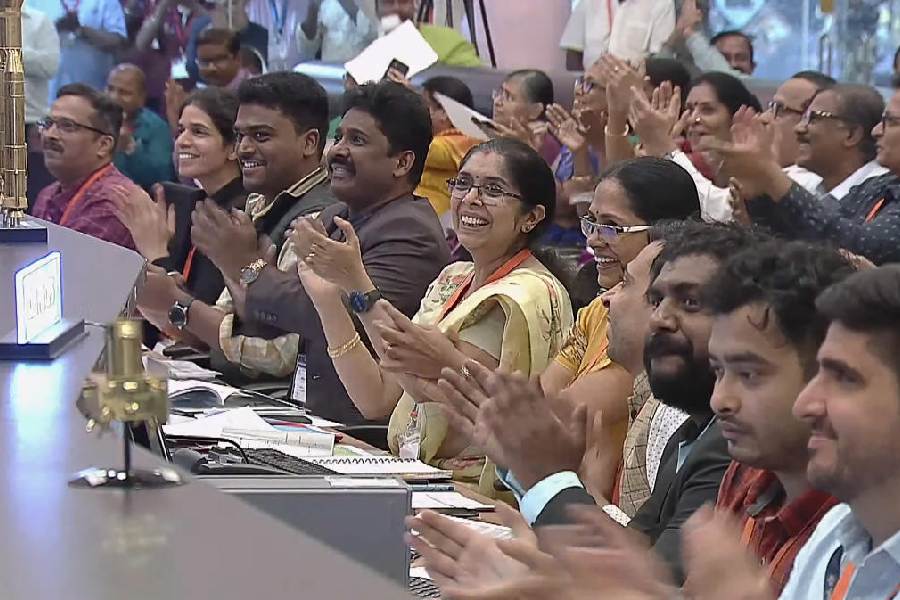The Chandrayaan-3 lander module touched down on the lunar surface on Wednesday, making India the first country to reach the lunar south pole region and the fourth country to land a spacecraft on the moon after Russia, the US and China.
The lander, entirely under the control of an onboard computer, nudged itself out of lunar orbit at an altitude of 30km. Rocket engines slowed its speed and smaller thrusters kept it steady during its 19-minute descent — until the soft landing around 6.04pm IST.
The live-streamed descent sequence was watched by millions across the country and by Prime Minister Narendra Modi who is in Johannesburg, South Africa, on an official visit.
“Aadarniya pradhan mantri ji, namaskar. Sir, we have achieved soft-landing on the moon. India is on the moon,” Isro chairman S. Somanath told the Prime Minister.
The mission control complex in Bangalore has established a communication link with the lander and ground control engineers and scientists were on Wednesday night preparing for post-landing operations, including the release of the rover.
The lander is expected to release the six-wheeled rover that is programmed to explore the lunar terrain near the landing site, which is an unexplored region of the moon about 650km from the lunar south pole. Both the lander and rover carry scientific instruments and are designed to function for one lunar day — or 14 Earth days.
The successful soft landing bolsters India’s position in the club of space-faring nations and reinforces Isro’s capacity to pull off ambitious space missions at relatively modest costs, aerospace experts and space industry executives said.
The Chandrayaan-3 mission cost about Rs 615 crore or less than $75 million which, some commentators on social media have flagged as being less than the budget of the 2014 Hollywood film Interstellar.
“Isro has once again demonstrated a cost-effective and high-precision mission,” said Pawan Kumar Chandana, the chief executive officer at Skyroot Aerospace, a private company developing rockets for satellite launch services, who was not associated with the Chandrayaan-3 mission.
The landing drew applause from the US National Aeronautics and Space Administration (Nasa) and the European Space Agency (ESA). Both Nasa and ESA are providing support to the Chandrayaan-3 mission through ground stations.
Bill Nelson, the Nasa administrator, posted on X (formerly Twitter): “Congratulations to India on being 4th country to successfully soft land a spacecraft on the Moon. We’re glad to be your partner on this mission.”
“Congratulations ISRO on this historic landing. ESA is proud to support the Chandrayaan-3 mission,” Rolf Densing, the director of operations at ESA’s mission operations centre in Darmstadt, Germany, said in a statement. ESA said it was looking forward to supporting the lander and rover operations.
Space agency officials are hoping the success will help bring momentum and funding to other projects currently in nascent stages. “We’re now looking at putting a man in space, putting a spacecraft around Venus, and landing a craft on Mars,” said M. Sankaran, the director of the UR Rao Satellite Centre, Bangalore. “Work on all these activities is going on for some years.... This success today will inspire us to strengthen those efforts,” he said.
The Chandrayaan-3 spacecraft marks Isro’s third lunar mission after the Chandrayaan-1 lunar orbiter in 2008 and the Chandrayaan-2 attempted lander in 2019. The Chandrayaan-2 lander had crashed after failures during its final descent phase.
Aerospace experts say the task of soft landing spacecraft is more challenging than launching one. “Among the five most recent lunar landing attempts, four, including Chandrayaan-2, ended in failures,” Chandana said. Israel and Japan have also lost spacecraft during attempted landings over the past four years and Russia’s Luna 25 spacecraft crashed on the moon last Sunday.
On Wednesday, the Chandrayaan-3 lander module activated its descent at the designated 5.44pm and executed the four phases of landing — rough breaking phase, altitude holding phase, fine breaking phase and terminal descent phase — “flawlessly”, an Isro official said.
The landing took place within the designated 4km by 2.5km area, located near the Manzinus and Bouguslawsky craters, about 650km from the south pole. Scientists who helped select the site have said it meets the requirements of sun illumination and radio communication with Earth. The sunlight is needed for the solar panels that will power the lander and rover.
“This is an unexplored area of the moon,” said Anil Bharadwaj, director of the Physical Research Laboratory, Ahmedabad, an Isro centre that developed scientific payloads for studies after the landing. “We’re preparing for the post-landing operations,” he said.
Among the planned experiments is one that will use a needle-like thermometer probe that will be inserted up to 10cm into the lunar surface to study its heat transfer properties. Another payload will measure seismicity around the landing site.
The instruments are expected to yield fresh insights into lunar geology and data on heat, if any, from the moon’s interior. Two other instruments called spectroscopes on the rover will probe the chemical and mineral composition of the lunar surface and rocks near the landing area.












